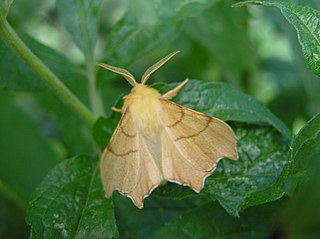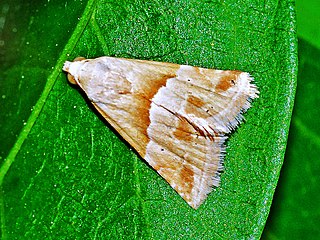
The red underwing is a moth of the family Erebidae. The species was first described by Carl Linnaeus in his 1767 12th edition of Systema Naturae.

The scalloped oak is a moth of the family Geometridae. The species was first described by Carl Linnaeus in his 1758 10th edition of Systema Naturae.

The mottled beauty is a moth of the family Geometridae. The species was first described by Carl Linnaeus in his 1758 10th edition of Systema Naturae.

Callistege mi, the Mother Shipton moth, is a moth of the family Erebidae. It was classified by Carl Alexander Clerck in 1759, and is also known under the name of Euclidia mi. In Finnish it is known as piirtoyökkönen and in German as Scheck-Tageule.

The mouse moth is a moth of the family Noctuidae. It is a widespread species with a Holarctic distribution.

Ennomos erosaria, the September thorn, is a moth of the family Geometridae. The species can be found in the Palearctic realm in western Europe and from central Scandinavia. Its range extends to the northern Mediterranean and east to the Caucasus and Russia. It is widespread in mixed and deciduous forests in Europe. The south eastern occurrence reaches Turkey and the Caucasus. The main habitat is dry deciduous forests and parks. In the Southern Alps, the species rises to an altitude of about 1600 metres.

Orthosia populeti, the lead-coloured drab, is a moth of the family Noctuidae. It is found in Europe.

Pyrausta despicata, the straw-barred pearl, is a species of moth of the family Crambidae. It was described by Giovanni Antonio Scopoli in his 1763 Entomologia Carniolica.

Diacrisia sannio, the clouded buff, is a moth of the family Erebidae. The species was first described by Carl Linnaeus in his 1758 10th edition of Systema Naturae. It is found in the Palearctic realm from Ireland to Siberia. It is not found in North Africa. In the Russian Far East, eastern China, Korea, and Japan it is replaced by Diacrisia irene.

Setina irrorella, the dew moth, is a moth of the family Erebidae. The species was first described by Carl Linnaeus in his 1758 10th edition of Systema Naturae. It is found in the Palearctic from Ireland, then through Europe and east to northern and central Asia to the Pacific Ocean. It is missing in the high north and parts of the Mediterranean region. It is found also in the limestone Alps up to 2,000 meters above sea level.

Mythimna conigera, the brown-line bright-eye, is a moth of the family Noctuidae.

Anania fuscalis is a species of moth of the family Crambidae. It is found in Europe.

The lunar-spotted pinion is a moth of the family Noctuidae.
Blastobasis inana is a moth of the family Blastobasidae. It was first described by Arthur Gardiner Butler in 1881 from Hawaii, but it is a widely dispersed species whose distribution includes India, New Britain and French Polynesia.

Eublemma parva, the small marbled, is a moth of the family Erebidae. The species was first described by Jacob Hübner in 1808.

Pyrausta lethalis, the lethal pyrausta moth, is a moth in the family Crambidae. It was described by Augustus Radcliffe Grote in 1881. It is found in North America, where it has been recorded from California to southern Nevada, southern Arizona and Texas.
Dichomeris straminis is a moth in the family Gelechiidae. It was described by Walsingham in 1881. It is found in Mozambique, South Africa and Zimbabwe.
Protolychnis maculata is a moth in the family Lecithoceridae. It was described by Walsingham in 1881. It is found in the Democratic Republic of Congo (Orientale), Namibia, South Africa, Tanzania and Zimbabwe.
Glycynympha roseocostella is a moth in the family Xyloryctidae, and the only species in the genus Glycynympha. The species was described, as Cryptolechia roseocostella, by Thomas de Grey, 6th Baron Walsingham in 1881 and is found in South Africa. The genus was established by Edward Meyrick in 1925.
Odites dilutella is a moth in the family Depressariidae. It was described by Lord Walsingham in 1881. It is found in South Africa.














